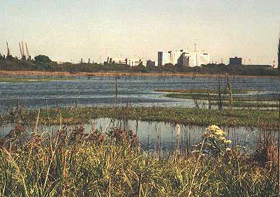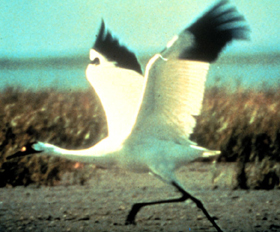 |
 |
 |
 |
| Volume
3 - Issue 12 DECEMBER 2005 |
|
Return to the Feature: God, Man And Water WETLANDS Wetlands vary widely, and are found from the tundra to the tropics and on every continent except Antarctica. Inland wetlands are most common on floodplains along rivers and streams (riparian wetlands), in isolated depressions surrounded by dry land, along the margins of lakes and ponds, and in other low-lying areas. Inland wetlands include marshes and wet meadows, and swamps dominated by trees. Many of these wetlands are seasonal (they are dry one or more seasons every year) and, particularly in the arid and semi-arid regions, may be wet only occasionally. The quantity of water present and the timing of its presence determine partly the functions of a wetland and its role in the environment. Even wetlands that appear dry at times for significant parts of the year, often provide critical habitat for wildlife adapted to breeding exclusively in these areas. Wetlands are among the most productive ecosystems in the world, comparable to rain forests and coral reefs. An immense variety of species of microbes, plants, insects, amphibians, reptiles, birds, fish, and mammals can be part of a wetland ecosystem. Physical and chemical features such as climate, landscape shape (topology), geology, and the movement and abundance of water help to determine the plants and animals that inhabit each wetland.
The functions of a wetland and the values of these functions to human society depend on a complex set of relationships between the wetland and the other ecosystems in the watershed. A watershed is a geographic area in which water, sediments, and dissolved materials drain from higher elevations to a common low-lying outlet or basin, a point on a larger stream, lake, underlying aquifer, or estuary. Wetlands play an integral role in the ecology of the watershed. The combination of shallow water, high levels of nutrients, and primary productivity is ideal for the development of organisms that form the base of the food web and feed many species of fish, amphibians, shellfish, and insects. Many species of birds and mammals rely on wetlands for food, water, and shelter, especially during migration and breeding. Wetlands' microbes, plants, and wildlife are part of global cycles for water, nitrogen, and sulphur. Furthermore, scientists are beginning to realize that atmospheric maintenance may be an additional wetlands function. Wetlands store carbon within their plant communities and soil instead of releasing it to the atmosphere as carbon dioxide. Thus wetlands help to moderate global climate conditions. Return to the Feature: God, Man And Water - The H2H Team |
| You can write to us at : h2h@radiosai.org |
Vol 3 Issue 12 - December 2005
|
Best viewed in Internet Explorer - 1024 x 768 resolution. |
DHTML Menu by Milonic. |
 Wetlands are areas where water covers the soil, or is present either at or near the surface of the soil all year or for varying periods of time during the year. The prolonged presence of water creates conditions that favour the growth of specially adapted plants, and promote the development of characteristic wetland soils.
Wetlands are areas where water covers the soil, or is present either at or near the surface of the soil all year or for varying periods of time during the year. The prolonged presence of water creates conditions that favour the growth of specially adapted plants, and promote the development of characteristic wetland soils. Wetlands can be thought of as biological “supermarkets." They provide great volumes of food that attract many animal species. These animals use wetlands for part of or all of their lifecycle. Dead plant leaves and stems break down in the water to form small particles of organic material called "detritus." This enriched material feeds many small aquatic insects, shellfish, and small fish that are food for larger predatory fish, reptiles, amphibians, birds, and mammals.
Wetlands can be thought of as biological “supermarkets." They provide great volumes of food that attract many animal species. These animals use wetlands for part of or all of their lifecycle. Dead plant leaves and stems break down in the water to form small particles of organic material called "detritus." This enriched material feeds many small aquatic insects, shellfish, and small fish that are food for larger predatory fish, reptiles, amphibians, birds, and mammals.